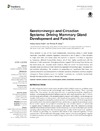Identificador persistente para citar o vincular este elemento:
https://accedacris.ulpgc.es/handle/10553/21867
| Campo DC | Valor | idioma |
|---|---|---|
| dc.contributor.author | Suárez-Trujillo, Aridany | en_US |
| dc.contributor.author | Casey, Theresa M. | en_US |
| dc.contributor.other | Suarez-Trujillo, Aridany | - |
| dc.date.accessioned | 2017-05-25T02:30:30Z | - |
| dc.date.accessioned | 2018-04-25T13:48:43Z | - |
| dc.date.available | 2017-05-25T02:30:30Z | - |
| dc.date.available | 2018-04-25T13:48:43Z | - |
| dc.date.issued | 2016 | en_US |
| dc.identifier.issn | 1664-042X | en_US |
| dc.identifier.uri | https://accedacris.ulpgc.es/handle/10553/21867 | - |
| dc.description.abstract | Since lactation is one of the most metabolically demanding states in adult female mammals, beautifully complex regulatory mechanisms are in place to time lactation to begin after birth and cease when the neonate is weaned. Lactation is regulated by numerous different homeorhetic factors, all of them tightly coordinated with the demands of milk production. | en_US |
| dc.format | application/pdf | es |
| dc.language | eng | en_US |
| dc.relation.ispartof | Frontiers in Physiology | en_US |
| dc.rights | by-nc-nd | es |
| dc.source | Frontiers in Physiology [ISSN 1664-042X], v. 7 (301) | en_US |
| dc.subject | 240113 Fisiología animal | en_US |
| dc.subject | 3109 Ciencias veterinarias | en_US |
| dc.subject.other | Serotonin | en_US |
| dc.subject.other | Circadian clocks | en_US |
| dc.subject.other | Mammary gland | en_US |
| dc.subject.other | Lactation | en_US |
| dc.subject.other | Home ostasis | en_US |
| dc.subject.other | Home orhesis | en_US |
| dc.title | Serotoninergic and circadian systems: driving mammary gland development and function | en_US |
| dc.type | info:eu-repo/semantics/Article | en_US |
| dc.type | Article | en_US |
| dc.identifier.doi | 10.3389/fphys.2016.00301 | |
| dc.identifier.scopus | 84981503274 | - |
| dc.identifier.isi | 000379733500001 | - |
| dcterms.isPartOf | Frontiers In Physiology | - |
| dcterms.source | Frontiers In Physiology[ISSN 1664-042X],v. 7 | - |
| dc.contributor.authorscopusid | 55572717800 | - |
| dc.contributor.authorscopusid | 35616075200 | - |
| dc.identifier.crisid | 27227;- | - |
| dc.relation.volume | 7 | - |
| dc.investigacion | Ciencias | en_US |
| dc.project.reference | FPU 12/06079; EST 14/00493 | es |
| dc.rights.accessrights | info:eu-repo/semantics/openAccess | es |
| dc.type2 | Artículo | en_US |
| dc.identifier.wos | WOS:000379733500001 | - |
| dc.contributor.daisngid | 4674080 | - |
| dc.contributor.daisngid | 304226 | - |
| dc.identifier.investigatorRID | P-4273-2016 | - |
| dc.contributor.wosstandard | WOS:Suarez-Trujillo, A | |
| dc.contributor.wosstandard | WOS:Casey, TM | |
| dc.date.coverdate | Julio 2016 | |
| dc.identifier.ulpgc | Sí | es |
| dc.description.sjr | 1,765 | |
| dc.description.jcr | 4,134 | |
| dc.description.sjrq | Q1 | |
| dc.description.jcrq | Q1 | |
| dc.description.scie | SCIE | |
| item.grantfulltext | open | - |
| item.fulltext | Con texto completo | - |
| crisitem.author.orcid | 0000-0002-9343-5016 | - |
| crisitem.author.fullName | Suárez Trujillo, Aridany | - |
| Colección: | Artículos | |
Citas SCOPUSTM
14
actualizado el 25-may-2025
Citas de WEB OF SCIENCETM
Citations
11
actualizado el 25-may-2025
Visitas
106
actualizado el 17-may-2025
Descargas
162
actualizado el 17-may-2025
Google ScholarTM
Verifica
Altmetric
Comparte
Exporta metadatos
Los elementos en ULPGC accedaCRIS están protegidos por derechos de autor con todos los derechos reservados, a menos que se indique lo contrario.
